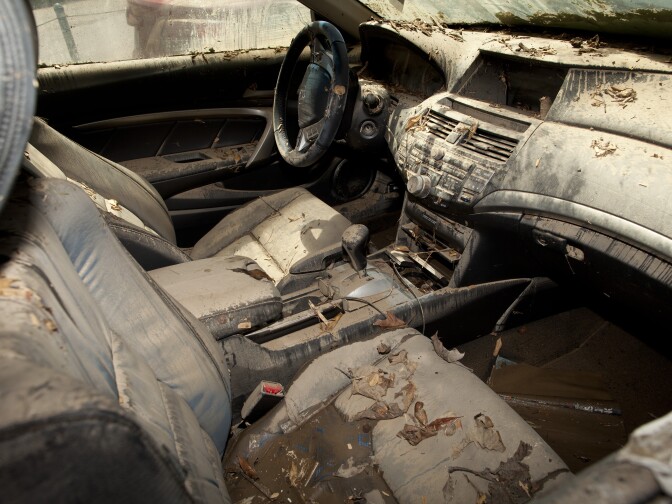With our free press under threat and federal funding for public media gone, your support matters more than ever. Help keep the LAist newsroom strong, become a monthly member or increase your support today.
UCLA flood takes a toll on LADWP's image and rate hike campaign
It's been a year since a 30-inch water pipe burst on Sunset Boulevard, spewing 20 million gallons of water down into the UCLA campus -- about four percent of what the city uses in a day.
Insurance will cover most tangible losses from the flood, but an intangible casualty could be the Los Angeles Department of Water and Power's campaign for higher water rates. At issue is whether the public and the decision-makers at the DWP and City Council see the higher rates as necessary to protect and improve the water system.
Water rates for all but the most water-frugal households would go up about 3 to 5 percent each of the next five years if the DWP board and City Council approve a plan rolled out by the utility's managers this month. Most of the added water rates would go to water system upgrades, accelerating replacement of more of the DWP's 7,000 miles of aging water pipe.
UCLA graduate Hannah Barnick would be tough to sell on the new water rates. Last year, her 1999 Nissan Pathfinder was parked on the lowest level of Parking Structure 4 when it filled up with water.
"I'd just gotten back from Washington DC so all my belongings were in my car while I was looking for another place to live," she said. She had been staying in various friends' homes. Her SUV had "everyday living things, I had sports equipment, I had work uniforms, there were about 140 items that were in my car."
When she found her vehicle a week later in a tow lot, she opened it and was nearly knocked over by the moldy stench. She laid her belongings out to dry and be photographed for her reimbursement claim, but none of it was salvageable, including irreplaceable notes for a research project.
"It was a worst-case scenario," she said.
After going through DWP's claims process she's satisfied to have received $7,000 on her claimed loss of $8,000.
The flood took an emotional toll as well. She won't park underground anymore at UCLA. She doesn't trust the DWP to have fixed its pipes.
"There's no reason to believe this won't happen again," she said. "Anytime these kinds of events happen and then there is a rate hike, I think people get really concerned about what that money is actually going to."
The question Barnick and ratepayers like her are asking is how aggressively is DWP replacing worn pipes, and how well is it assessing the risk of major breaks and the collateral damage they can cause?
DWP and its rate payers are not exposed to the full financial burden of a pipe break. The DWP's insurance will cover all but $3 million of the nearly $15 million in damage to Pauley Pavilion, other athletic buildings, two parking structures and hundreds of student and employee vehicles caught under water.
The pipe that broke above UCLA wasn't seen as having a high risk of failure, DWP officials told members of the City Council in a post-mortem report. But it's symptomatic of a system that is getting too old, too broken, too fast.
The 30-inch broken pipe up on Sunset Boulevard was 90 years old,at a "Y" junction with two younger pipes from the '30s and '50s. It was rotted through with corrosion and bad welds.
The DWP is on pace to replace its entire pipe system every 300 years or so, and it says it can cut that cycle to once every 150 years with the rate increase. But most of its pipes last only about 90 years.
DWP General Manager Marcie Edwards said breaks like the UCLA/Sunset flood can help DWP make a case that it urgently needs more money to replace more pipes. She joked during a recent media briefing on the rates that she wished she had the request pending before the City Council when the UCLA flood happened last year.
But pipe breaks that turn into a cascading disaster like the UCLA flood leave the public with less trust in the agency, and unwilling to pay more, said Richard Little, an infrastructure policy consultant and former head of USC's Keston Institute for Public Finance and Infrastructure Policy.
He says the DWP has an uphill battle gaining the public's trust after breaks like the UCLA flood.
"They ought to be able to demonstrate to the public and to the decision makers who get elected by the public that they are doing a credible job in trying to manage the risks, and not just tell people, 'We've got it under control,'" He said.
Joe Ramallo, chief spokesman for the DWP says the public doesn't get an accurate picture of the utility's low number of leaks -- just three a day on average -- or its programs to find and replace the riskiest pipes. They just focus on the big breaks like UCLA.
"The ones that get the most attention on the media do give some distorted view of what the problem is," he said.
A recent analysis of the DWP's claims paid on pipe breaks found that it is less costly to pay damage claims than to replace pipes.
Ramallo said the agency doesn't just wait for pipes to break, because it's too expensive. It costs about three times as much to fix a break like the one at UCLA than it would to replace it before the break occurs.
The public doesn't see that the DWP has doubled the linear feet of water lines replaced annually and cut the rate of water leaks by 40 percent in the past decade, Ramallo said
"There's no doubt that we need to do more pipe at a faster rate than we've been doing. That's part of what we're talking about with this proposal," he said. "How do we ramp it up steadily over time, in a way that our customers can afford, that we can accomplish and that traffic can bear?"
Even if it had money for massive pipe replacements, the DWP would still need to pace the work over time to match its supply of labor and equipment, and to keep the public from getting angry over streets being torn up all the time, he said.
The water rates proposal will be circulated among the public for the next few months. The DWP Board of Commissioners would vote in late October, with the City Council giving it a yes-or-no vote by November or December.














